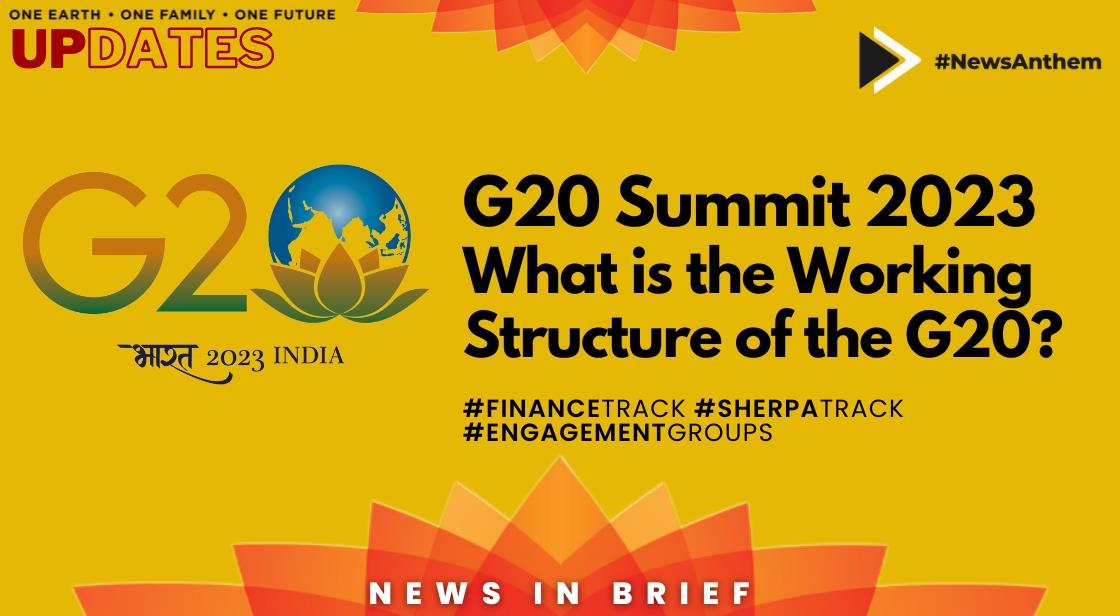G20 Summit 2023: What is the working structure of the G20?

News Synopsis
As global leaders converge in India for the G20 Summit 2023, the world's top economies come together to address pressing global challenges. Delhi, the national capital, is bedecked to welcome the delegates for this two-day summit, held on September 9-10.
The grandeur of the main venue, Bharat Mandapam at Pragati Maidan, with its illuminations, floral decorations, and a striking 28-foot-tall Nataraja statue, sets the stage for this momentous event. The summit carries the optimistic banner of "One Earth, One Family, One Future," reflecting a shared vision of unity and progress.
The Working Structure of the G20
The G20, comprising leaders from the world's foremost economies, operates within a well-defined working structure that encompasses three major tracks:
1. Finance Track
The Finance Track is steered by finance ministers and central bank governors, convening approximately four times annually. Within this track, critical discussions revolve around fiscal and monetary policy matters that have a far-reaching impact on the global economy.
Key areas of focus include:
-
Global Economy: Assessment and strategies for fostering global economic stability.
-
Infrastructure: Discussion of infrastructure development to promote economic growth.
-
Financial Regulation: Deliberations on financial sector regulations and reforms.
-
Financial Inclusion: Efforts to ensure financial services are accessible to all.
-
International Financial Architecture: Evaluation of the global financial system's structure.
-
International Taxation: Addressing international taxation issues on a global scale.
At present, the Finance Track comprises eight working groups that delve into these crucial areas, driving policy discussions and recommendations.
3. Sherpa Track
The Sherpa Track, established in 2008 alongside the G20 Leaders' Summit, is helmed by Sherpas—appointed representatives of member countries' presidents or prime ministers. This track zeroes in on a wide spectrum of socio-economic issues, including:
-
Agriculture: Strategies for sustainable agricultural practices.
-
Anti-Corruption: Efforts to combat corruption on a global scale.
-
Climate: Discussions on climate change mitigation and adaptation.
-
Digital Economy: Advancements and regulations in the digital sphere.
-
Education: Initiatives for quality education worldwide.
-
Employment: Policies to foster global employment opportunities.
-
Energy: Strategies for sustainable and clean energy sources.
-
Environment: Measures to address environmental challenges.
-
Health: Collaborative efforts in global health crises.
-
Tourism: Promotion of sustainable and responsible tourism.
-
Trade: Trade policies and agreements among member nations.
-
Investment: Strategies for fostering global investment.
Currently, the Sherpa Track comprises 13 working groups, each contributing to policy formulation and recommendations in their respective areas.
3. Engagement Groups
The third and unofficial track of the G20 consists of Engagement Groups, which comprise non-governmental participants from each member country. These groups play a pivotal role by drafting recommendations to G20 leaders. Their input contributes to the policy-making process on various issues. Presently, there are 11 Engagement Groups, covering diverse areas of global concern.
Conclusion:
Understanding the working structure of the G20 reveals the depth and breadth of discussions that shape global policies. With leaders from major economies coming together, the G20 Summit 2023 in India promises to address crucial matters, guided by the Finance Track, Sherpa Track, and valuable insights from Engagement Groups.
You May Like









